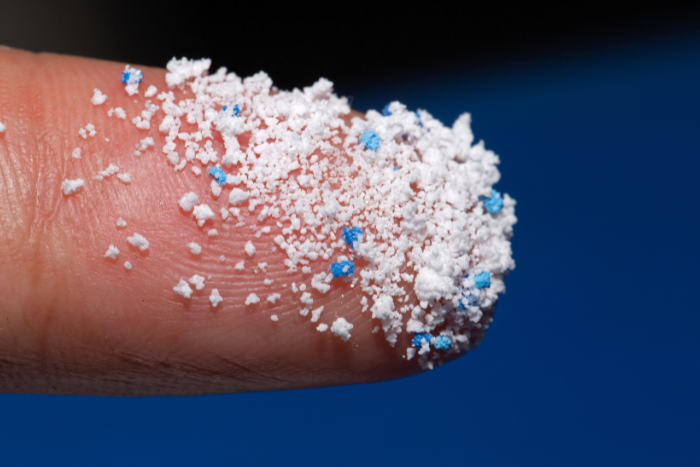Microplastics are present in all salt and sugar samples, in forms such as fibre, pellets, films and fragments, said a study by environmental research organisation Toxic Links. The size of these microplastics ranged from 0.1 mm to 5 mm.
Researchers tested 10 types of salt — including table salt, rock salt, sea salt and local raw salt — and five types of sugar purchased from both online and local markets. The highest amount of microplastics was found in iodised salt (89.15 pieces per kg), while organic rock salt had the lowest amount (6.70 pieces per kg). Toxics Link founder-director Ravi Agarwal told PTI: “The objective of our study was to contribute to the existing scientific database on microplastics so that the global plastic treaty can address this issue in a concrete and focused manner.”
The concentration of microplastics in the salt samples ranged from 6.71 to 89.15 pieces per kilogramme of dry weight, the report said. Microplastics can cause inflammation and oxidative stress in tissues, potentially leading to long-term damage, including cardiovascular diseases and cancer, TOI reported.
Vedanta to pay green fine of ₹71.16 crore for unauthorised dumping of fly ash in Odisha
Vedanta group will have to pay Odisha State Pollution Control Board environmental compensation of ₹71.16 crore for unauthorised dumping of fly ash without its prior permission at its aluminium smelter and captive power plant in Jharsuguda district. Fly ash, a residue of coal combustion in thermal power plants, poses environmental risks when disposed of improperly as it can contaminate water sources. The Hindu reported that the pollution control body found dumping of fly ash in the open as violation of fly ash notification of Ministry of Environment and Forest and Climate Change.
Dangerous increase in ozone pollution across urban India noticed: CSE
Ground-level ozone pollution is on the rise across India’s major cities, a new study by Delhi-based think-tank Centre for Science and Environment (CSE) revealed. This invisible gas, unlike the more familiar fine particulate matter, also known as PM2.5, poses a serious health threat, particularly to those with respiratory problems. The report, Air Quality Tracker: An invisible threat, was released August 6, 2024. The researchers analysed metropolitan areas of Bengaluru (Karnataka), Chennai (Tamil Nadu), Kolkata (West Bengal), Mumbai and Pune (Maharashtra). They also looked at data for Delhi-National Capital Region, Greater Ahmedabad (Gujarat), Greater Hyderabad (Telangana), Greater Jaipur (Rajasthan) and Greater Lucknow (Uttar Pradesh), reported DTE.
Fracking from oil and gas wells produced 85% of global saline wastewater: Study
A new study found that fracking from oil and gas wells contributed to over 85% of the hundreds of billions of tonnes of highly saline wastewater in North America from 2005-19. Substantial volumes of highly saline wastewater poses “environmental concerns”, the study said.
The researchers introduced two parameters to “better assess” the environmental impact of this wastewater. Analysing a database of 620,000 wells in the US and Canada, they found that more than 355 billion tonnes of salts were produced from 2005-19. Projections suggest that more than 1.5 trillion tonnes of salts will be produced by wells from 2019-50, “predominantly” from fracking, the study added.
Liquefied natural gas pollution linked to 60 premature US deaths a year: Study
Air pollution from LNG (liquified natural gas) export terminals results in an estimated 60 premature deaths and $957 million in total health costs each year, said a new study, which added that if all planned and proposed terminals come online, those numbers would shoot up to 149 premature deaths and $2.33 billion, reports the Guardian.
The analysis comes seven months after the Biden administration froze all new LNG export approvals until energy regulators update their approval process to consider the climate impact of new proposals. Federal officials are currently defending the pause in court. Officials should take this opportunity to consider the health effects of LNG terminals in addition to their climate toll, the authors say.
Study: Toxic PFAS can escape from landfills into the air
New research shows toxic ‘forever chemicals’ gas may escape in the air through landfills and threaten the environment, reports the Guardian. PFAS gas that forms in the landfill waste turns highly concentrated in the facilities’ gas treatment systems, which are not equipped to manage or destroy the chemicals, and much of them probably end up in the environment, the report said. The findings, which showed up to three times as much PFAS in landfill gas as in leachate (wastewater from landfills), are “definitely an alarming thing for us to see”, Ashley Lin, a University of Florida researcher and the lead author of the study told the Guardian.
About The Author
You may also like
Govt Says No Conclusive Data Relating Deaths to Pollution
Parents, Activists Protests at India Gate as Air Turns Toxic
Top court allows ‘green firecrackers’ in Delhi on Diwali with conditions
CPCB should help industry meet green norms: Environment Minister
Noise pollution from trains hit surrounding homes, exceed limits by 85%

